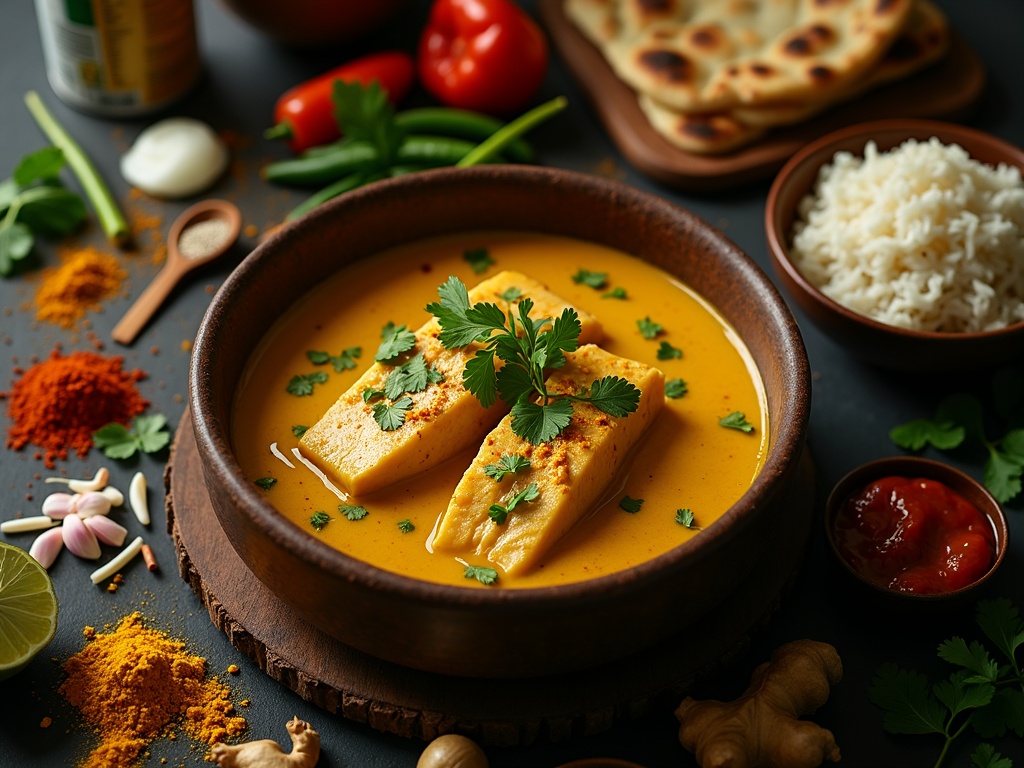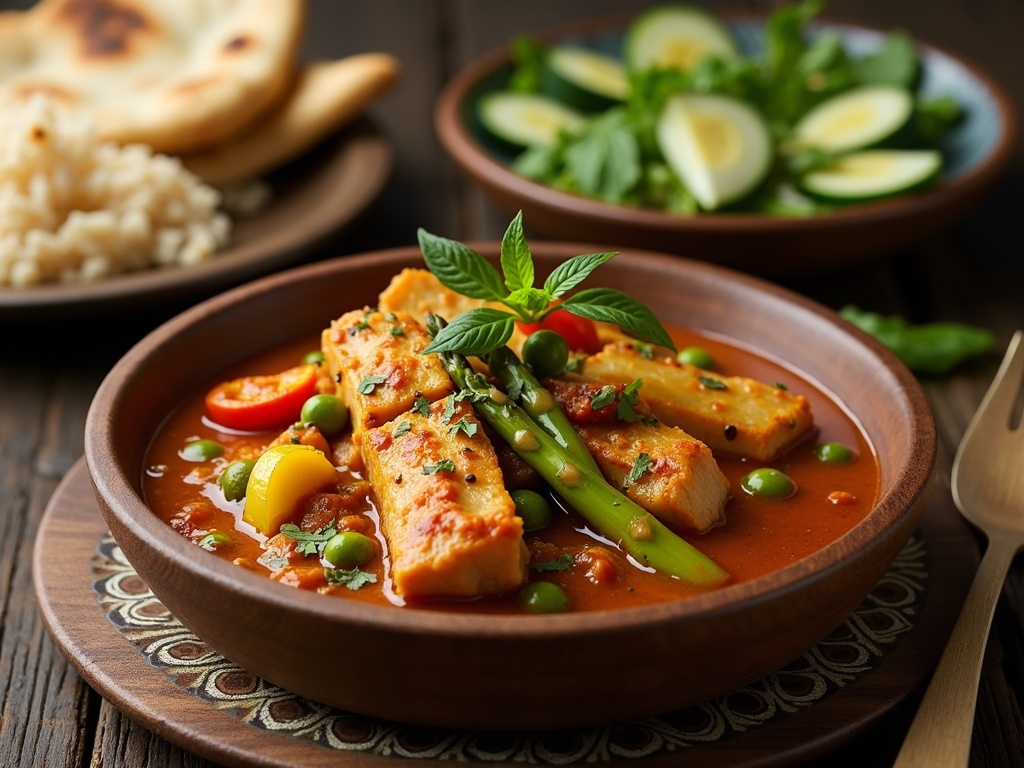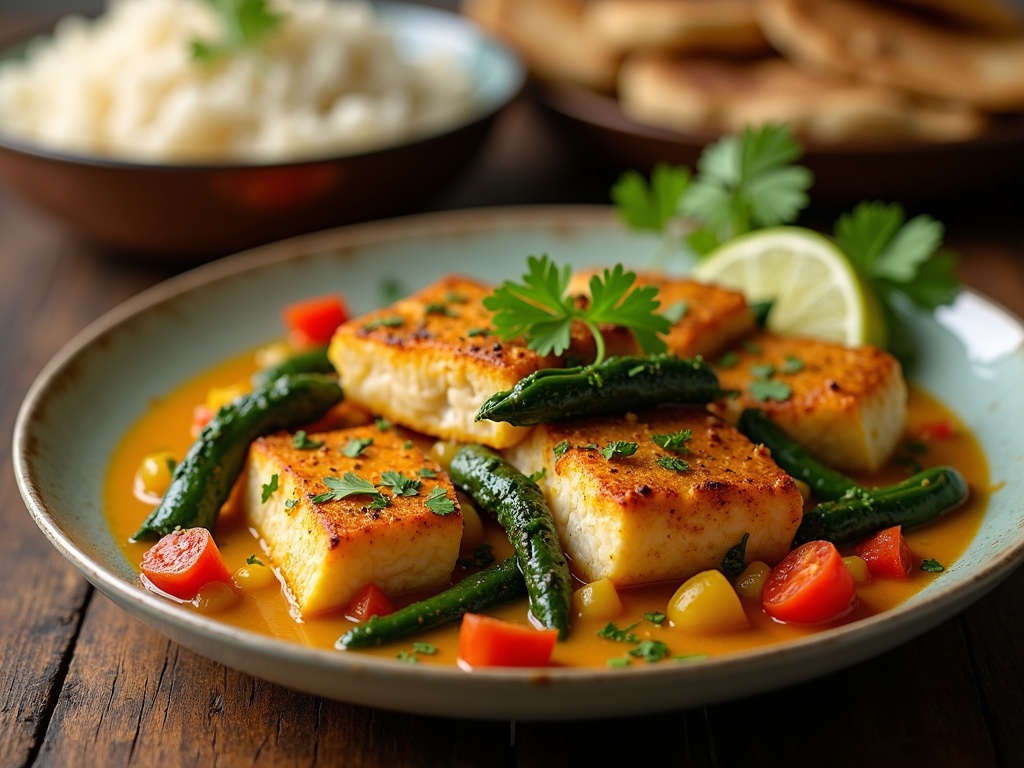Fish curry recipe combines heart-healthy omega-3 benefits of fish with anti-inflammatory spices like turmeric, cumin, and coriander, creating a nutritious yet delicious meal option. The dish delivers about 20-25 grams of high-quality protein per serving while potentially cutting cardiovascular risks by up to 30%, according to the American Heart Association.
Find In This Article
Key Takeaways
- Fatty fish varieties like salmon and mackerel offer the most health benefits in curry dishes due to their high omega-3 content.
- The signature curry spices provide additional health benefits: turmeric fights inflammation, cumin improves digestion, and coriander supports healthy cholesterol levels.
- Each serving contains approximately 350 calories with 15g of protein, making it a satisfying yet reasonable meal option.
- The recipe is highly adaptable – you can substitute coconut milk with vegetable broth for a lighter version or add seasonal vegetables for extra nutrition.
- Fish curry can be prepared in under 45 minutes, making it suitable for both weeknight dinners and special occasions.
Why Fish Curry Is Your Next Heart-Healthy Meal
Looking to improve your heart health while enjoying delicious food? I’ve found that fish curry ticks all the boxes. The American Heart Association reports that omega-3 fatty acids can reduce cardiovascular events by up to 30%, making this flavorful dish more than just a tasty dinner option.
Each 3.5-ounce serving of fish in your curry provides 20-25 grams of high-quality protein, supporting muscle maintenance and keeping you satisfied longer. I’ve noticed that fish curry offers a perfect balance of nutrition and flavor that’s hard to match with other dishes.
Powerful Spices, Powerful Benefits
The magic of fish curry extends beyond the fish itself. The signature spices deliver impressive health benefits:
- Turmeric contains curcumin, which fights inflammation and oxidative stress
- Cumin helps improve digestion and contains essential minerals
- Coriander supports healthy cholesterol levels and aids detoxification
A 2019 Journal of Nutrition study linked curcumin (found in turmeric) to reduced chronic disease risk, making that golden color in your curry more than just visually appealing.
Choosing the Best Fish for Your Curry
I’ve experimented with various fish types and found that fatty fish varieties deliver the most health benefits in curry dishes. Salmon stands out as an excellent choice, packing substantial omega-3 content and a firm texture that holds up well in the simmering sauce. It’s also fantastic in salmon en croute if you’re looking for another heart-healthy option.
Mackerel offers another omega-3 powerhouse option with a stronger flavor that pairs beautifully with bold curry spices. If you prefer milder fish, white fish varieties work wonderfully too – try them in a fish pie recipe for something different.
For those who enjoy variety, consider mixing different seafood types. A seafood chowder approach to your curry can introduce multiple nutritional profiles. If you’re new to fish cooking, start with a simple fish stew to build confidence.
The sweet-sour balance in many curry recipes enhances both flavor and nutritional absorption – similar to what makes sweet and sour fish so satisfying but with added spice benefits.
By incorporating fish curry into your meal rotation, you’re making a smart choice for your heart, taste buds, and overall wellness.
What You’ll Need to Make It
I’ve gathered all the essential ingredients to create a delicious fish curry that’s bursting with flavor. This recipe brings together aromatic spices, creamy coconut milk, and tender fish for a meal that’s both comforting and impressive.
Essential Ingredients
The foundation of any good fish curry starts with selecting the right fish. I recommend using 1 pound of firm white fish like cod, halibut, or tilapia, which hold their shape nicely during cooking rather than falling apart. For a different flavor profile, you could try a salmon fillet prepared in this curry base instead.
Your spice cabinet needs to provide some key players:
- 1 teaspoon of turmeric, which gives the curry its golden color
- 1 tablespoon of garam masala for depth and warmth
- 1 teaspoon of cumin seeds for earthy notes
The aromatics create a flavorful base:
- 1 medium onion, finely diced
- 3 garlic cloves, minced
- 1-inch piece of ginger, grated
For the rich, creamy sauce, you’ll need:
- 14 oz can of coconut milk
- 2 tablespoons of tomato paste
- 1 lime (juice and zest)
- Fresh cilantro for garnish
I love adding vegetables to make this a complete meal. Consider including:
- Bell peppers for sweetness and color
- Spinach for added nutrition
- Green beans for texture
If you’re looking for a lighter version, you can substitute half the coconut milk with vegetable broth. This approach reduces the richness while maintaining flavor, similar to how I make a lighter fish stew when I want something less heavy.
For those who enjoy seafood variety, this recipe can be adapted into a seafood medley by adding shrimp or scallops alongside the fish. The same curry base works beautifully with multiple seafood options.
Don’t forget the rice or naan bread to serve with your curry – they’re perfect for soaking up the delicious sauce. This recipe yields enough for 4 servings and can be prepared in under 45 minutes, making it ideal for both weeknight dinners and special occasions.

Cooking Your Perfect Fish Curry
I’ve learned through countless kitchen experiments that timing is everything when making a delicious fish stew or curry. Getting each stage right means the difference between bland disappointment and flavor-packed success.
The Building Blocks of Flavor
The foundation of any good fish curry starts with properly sautéed aromatics. I heat oil in a deep pan until it shimmers, then add finely chopped onions, garlic, and ginger. These need exactly 5 minutes to transform from raw and pungent to golden-brown and fragrant. Don’t rush this step – those caramelized sugars create the backbone of your curry.
Next comes the critical spice blooming phase. I add my curry powder, turmeric, cumin, and coriander to the hot oil and aromatics, stirring constantly for 2 minutes. This might seem brief, but it’s all you need to wake up those essential oils and transform your spices from flat powder to vibrant flavor. The kitchen should fill with an intoxicating aroma – that’s your signal everything’s going right.
The sauce development happens quickly afterward. I stir in tomato paste and cook for 2-3 minutes until it darkens slightly. This concentrates the tomato flavor and removes any tinny taste. Then I add coconut milk or broth, bringing everything to a gentle simmer. This creates the perfect swimming pool for your fish.
The Fish Factor
Adding fish requires care. I gently place seasoned fish pieces into the simmering sauce, spooning some liquid over them. The cooking time is 10-12 minutes – this works for most firm white fish varieties like cod, haddock, or snapper.
During this phase, I resist the urge to stir aggressively. Fish is delicate, and I want chunks in my curry, not flakes. Instead, I gently shake the pan occasionally or spoon sauce over the top.
The key indicator that your fish is perfectly cooked is when it flakes easily with a fork but still maintains its shape. If you’re unsure, test a larger piece – the flesh should be opaque all the way through.
This technique differs slightly from other fish dishes like sweet and sour fish or fish pie, where the cooking method and timing vary considerably.
Final touches make all the difference to your curry. Once the heat is off, I squeeze fresh lime juice over everything – the acidity balances the rich sauce perfectly. A generous handful of chopped cilantro adds color, freshness, and that distinctive herbal note that elevates home cooking to restaurant quality.
For texture contrast, I sometimes add a quick topping of crispy fried shallots. This provides a satisfying crunch against the tender fish and velvety sauce – similar to how breadcrumb toppings work in a salmon en croute.
If you prefer a heartier meal with more vegetables, you can adapt this method for a seafood chowder by adding diced potatoes early in the cooking process and mixed seafood during the final minutes.
I’ve found the timing in this recipe creates perfect results across different fish varieties. The gentle 10-12 minute cook preserves moisture and texture while allowing the fish to absorb the curry flavors. Let the curry rest for 5 minutes before serving – this allows flavors to settle and prevents burned mouths from overeager tasting!
Smart Substitutions and Variations
I’ve discovered several clever ways to adapt fish curry to suit different dietary needs and flavor preferences. The beauty of this dish lies in its flexibility – you can easily make it your own with a few tweaks.
Healthier and Seasonal Options
For a lighter version that cuts down on calories, I swap rich coconut milk for vegetable broth. This substitution maintains the curry’s delicious flavor profile while creating a thinner, less caloric sauce. The broth still carries the spices beautifully, allowing them to infuse the fish with their aromatic qualities.
Adding seasonal vegetables transforms basic fish curry into a complete meal packed with extra nutrition. Here are some excellent additions depending on the season:
- Spring: Asparagus, peas, or tender spinach
- Summer: Bell peppers, zucchini, or eggplant
- Fall: Butternut squash, cauliflower, or carrots
- Winter: Potatoes, sweet potatoes, or hearty greens
When it comes to serving this fragrant fish stew, I’ve found several accompaniments that complement it perfectly. Fluffy basmati rice makes an ideal base, soaking up the flavorful sauce. For something different, warm naan bread works wonderfully for scooping up the curry. On warmer days, I sometimes serve it with a fresh cucumber and mint salad for a refreshing contrast.
I often prepare a larger batch since the flavors in fish dishes tend to develop beautifully overnight. This curry keeps well in the refrigerator for up to 2 days, making it perfect for meal prep. To reheat, I gently warm it on the stovetop rather than using the microwave, which helps preserve the texture of the fish.
For those who enjoy seafood variety, this curry recipe adapts well to a mixed seafood approach. I sometimes include a combination of firm white fish along with shrimp or scallops for interesting textural contrasts.
If you’re looking for a more substantial presentation for special occasions, consider taking inspiration from a wrapped fish technique by serving the curry inside a hollowed bread bowl.
For a British-inspired twist that’s perfect for colder months, the spices used in this curry can be incorporated into a fish pie filling for a fusion dish that combines comfort food with exotic flavors.

Nutrition Facts You Should Know
This fish curry recipe packs impressive nutritional value while still delivering on taste. I’ve carefully balanced the ingredients to create a meal that’s both delicious and beneficial for your health. Each batch serves 4 people, making it perfect for family dinners or meal prep for the week.
Nutritional Breakdown Per Serving
When you sit down to enjoy a serving of this curry, you’re consuming approximately 350 calories – making it a reasonable option for those monitoring their caloric intake. The protein content stands at a solid 15g per serving, which comes primarily from the fish. This protein helps with muscle maintenance and keeps you feeling full longer.
The fat content is 25g per serving, with much of it coming from healthy sources like fish oils and the cooking oil used in preparation. The recipe contains 20g of carbohydrates per serving, primarily from the vegetables and any side dishes you might serve with it.
The nutritional benefits of this fish curry recipe extend beyond just the macronutrients. Fish is naturally rich in Vitamin D, which is essential for bone health and immune function. Many people don’t get enough Vitamin D in their daily diet, so this curry provides a tasty way to boost your intake.
Additionally, this dish offers a good amount of iron, which is vital for blood health and oxygen transport throughout your body. The combination of fish with iron-rich vegetables creates a meal that supports overall health and wellbeing.
The beauty of homemade curry is the flexibility it offers. If you’re following a specific dietary plan, you can easily adjust the portions or ingredients. Here are some ways to modify the recipe based on your personal nutritional needs:
- Reduce the oil or use a cooking spray to lower the fat content
- Add more vegetables to increase fiber and nutrients while keeping calories in check
- Use more fish to boost the protein content for athletic training
- Serve with brown rice instead of white rice for added fiber
- Add spinach or other leafy greens for additional iron
- Include coconut milk for healthy fats if desired
I’ve found that this fish-based meal works well for most balanced diets. It’s substantial enough to satisfy hunger while providing essential nutrients that support good health.
For those on restricted diets, note that the calorie count of 350 per serving doesn’t include side dishes like rice or bread. If you’re counting calories precisely, remember to factor those additions into your calculations.
The nutritional profile makes this curry a better choice than many takeout options, which often contain hidden sugars and unhealthy fats. By preparing this fish recipe at home, you control exactly what goes into your meal.
Athletes might want to increase the portion size or add a carb-rich side to fuel their activities, while those looking to lose weight might focus on the protein content while moderating the carbohydrate sides.
For a complete meal with excellent nutritional balance, consider serving this curry with a small portion of brown rice and a simple side salad. This combination provides additional fiber and micronutrients to complement the already nutrient-dense seafood curry.
Remember that the nutritional values provided are estimates and may vary slightly depending on the specific fish and brands of ingredients you use. Using a food scale when preparing ingredients can help you track nutrients more accurately if precise nutrition tracking is important to you.

Sources:
American Heart Association: Fish and Omega-3 Fatty Acids
Journal of Nutrition: Study on Curcumin and Chronic Disease Risk
USDA FoodData Central: Nutritional Information

